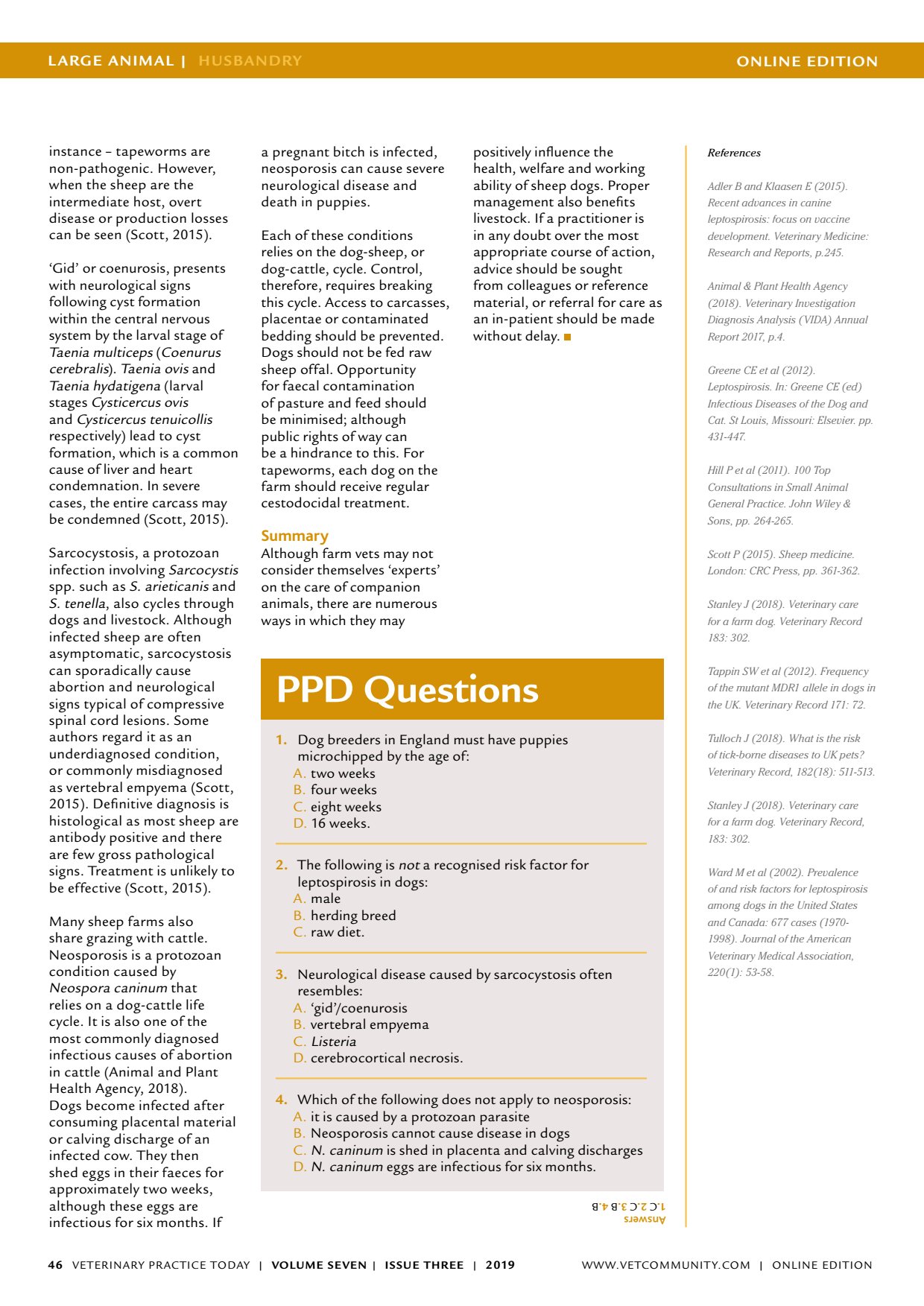Questions Summary ONLINE
ONLINE EDITIONL ARGE ANIMAL | HUSBANDRY VETERINARY PRACTICE TODAY | VOLUME SEVEN | ISSUE THREE | 2019 46 References Adler B and Klaasen E (2015). Recent advances in canine leptospirosis: focus on vaccine development. Veterinary Medicine: Research and Reports, p.245. Animal & Plant Health Agency (2018). Veterinary Investigation Diagnosis Analysis (VIDA) Annual Report 2017, p.4. Greene CE et al (2012). Leptospirosis. In: Greene CE (ed) Infectious Diseases of the Dog and Cat. St Louis, Missouri: Elsevier. pp. 431-447. Hill P et al (2011). 100 Top Consultations in Small Animal General Practice. John Wiley & Sons, pp. 264-265. Scott P (2015). Sheep medicine. London: CRC Press, pp. 361-362. Stanley J (2018). Veterinary care for a farm dog. Veterinary Record 183: 302. Tappin SW et al (2012). Frequency of the mutant MDR1 allele in dogs in the UK. Veterinary Record 171: 72. Tulloch J (2018). What is the risk of tick-borne diseases to UK pets? Veterinary Record, 182(18): 511-513. Stanley J (2018). Veterinary care for a farm dog. Veterinary Record, 183: 302. Ward M et al (2002). Prevalence of and risk factors for leptospirosis among dogs in the United States and Canada: 677 cases (1970- 1998). Journal of the American Veterinary Medical Association, 220(1): 53-58. PPD Questions 1. Dog breeders in England must have puppies microchipped by the age of: A. two weeks B. four weeks C. eight weeks D. 16 weeks. 2. The following is not a recognised risk factor for leptospirosis in dogs: A. male B. herding breed C. raw diet. 3. Neurological disease caused by sarcocystosis often resembles: A. gid/coenurosis B. vertebral empyema C. Listeria D. cerebrocortical necrosis. 4. Which of the following does not apply to neosporosis: A. it is caused by a protozoan parasite B. Neosporosis cannot cause disease in dogs C. N. caninum is shed in placenta and calving discharges D. N. caninum eggs are infectious for six months. Answers 1. C 2. C 3. B 4. B instance tapeworms are non-pathogenic. However, when the sheep are the intermediate host, overt disease or production losses can be seen (Scott, 2015). Gid or coenurosis, presents with neurological signs following cyst formation within the central nervous system by the larval stage of Taenia multiceps (Coenurus cerebralis). Taenia ovis and Taenia hydatigena (larval stages Cysticercus ovis and Cysticercus tenuicollis respectively) lead to cyst formation, which is a common cause of liver and heart condemnation. In severe cases, the entire carcass may be condemned (Scott, 2015). Sarcocystosis, a protozoan infection involving Sarcocystis spp. such as S. arieticanis and S. tenella, also cycles through dogs and livestock. Although infected sheep are often asymptomatic, sarcocystosis can sporadically cause abortion and neurological signs typical of compressive spinal cord lesions. Some authors regard it as an underdiagnosed condition, or commonly misdiagnosed as vertebral empyema (Scott, 2015). Definitive diagnosis is histological as most sheep are antibody positive and there are few gross pathological signs. Treatment is unlikely to be effective (Scott, 2015). Many sheep farms also share grazing with cattle. Neosporosis is a protozoan condition caused by Neospora caninum that relies on a dog-cattle life cycle. It is also one of the most commonly diagnosed infectious causes of abortion in cattle (Animal and Plant Health Agency, 2018). Dogs become infected after consuming placental material or calving discharge of an infected cow. They then shed eggs in their faeces for approximately two weeks, although these eggs are infectious for six months. If a pregnant bitch is infected, neosporosis can cause severe neurological disease and death in puppies. Each of these conditions relies on the dog-sheep, or dog-cattle, cycle. Control, therefore, requires breaking this cycle. Access to carcasses, placentae or contaminated bedding should be prevented. Dogs should not be fed raw sheep offal. Opportunity for faecal contamination of pasture and feed should be minimised; although public rights of way can be a hindrance to this. For tapeworms, each dog on the farm should receive regular cestodocidal treatment. Summary Although farm vets may not consider themselves experts on the care of companion animals, there are numerous ways in which they may positively influence the health, welfare and working ability of sheep dogs. Proper management also benefits livestock. If a practitioner is in any doubt over the most appropriate course of action, advice should be sought from colleagues or reference material, or referral for care as an in-patient should be made without delay. WWW.VETCOMMUNIT Y.COM | ONLINE EDITION
